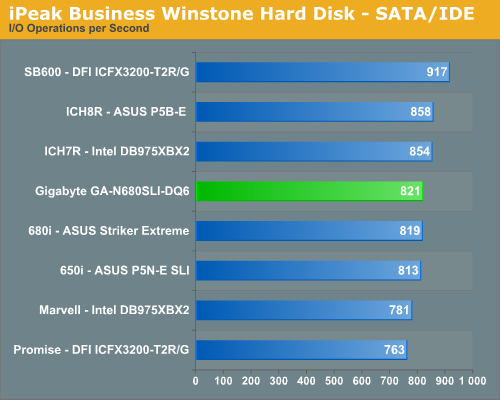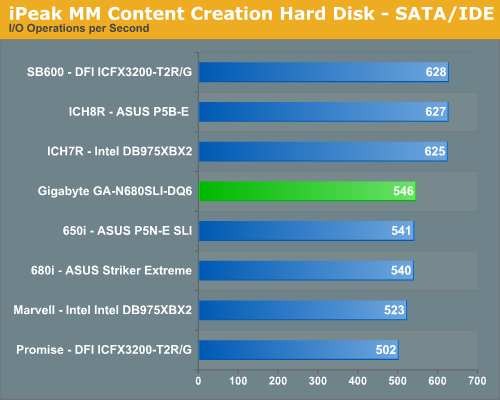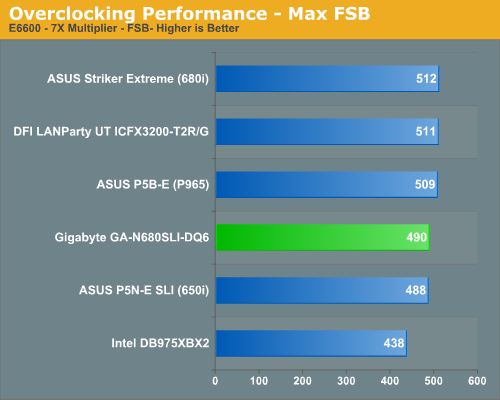Gigabyte GA-N680SLI-DQ6: Quad to the Extreme
by Gary Key on February 24, 2007 1:30 AM EST- Posted in
- Motherboards
Disk Controller Performance
The AnandTech iPeak test is designed to measure "pure" hard disk controller performance, and in this case, we keep the hard drive as consistent as possible while varying the hard drive controller. The idea is to measure the performance of each hard drive controller with the same hard drive.
We played back our raw files that are recorded I/O operations when running a real world benchmark - the entire Winstone 2004 suite. Intel's iPeak utility was then used to play back the trace file of all I/O operations that took place during a single run of Business Winstone 2004 and MCC Winstone 2004. To try to isolate performance differences to the controllers that we are testing we are using the Western Digital 74GB Raptor with 16MB cache for both our standard disk controller and RAID performance tests for this article. The drive is formatted before each test run and a composite average of three tests on each controller interface is tabulated in order to ensure consistency in the benchmark.
iPeak gives a mean service time in milliseconds; in other words, the average time that each drive took to fulfill each I/O operation. In order to make the data more understandable, we report the scores as an average number of I/O operations per second so that higher scores translate into better performance. This number is meaningless as far as hard disk performance is concerned, as it is just the number of I/O operations completed in a second. However, the scores are useful for comparing "pure" performance of the storage controllers in this case.


The performance patterns hold steady across both Multimedia Content I/O and Business I/O with the SB600 outperforming the Intel ICH7R, Intel ICH8R, and NVIDIA 680i/650i chipsets in our non-Raid tests. The Promise controller on the DFI board is the slowest of all solutions with the Marvell controller on the Intel 975X performing only slightly better. The 680i and 650i MCP units are different but their disk performance in our tests is basically alike. We also ran RAID 0 and RAID 5 tests on each controller with the results being in favor of the 680i MCP by around 2%. We did not witness any data corruption on either ASUS NVIDIA based board as has been reported on the 680i reference boards, and we consider this problem to be fixed since our P23 BIOS update. We did have data corruption issues with the Gigabyte board when using 1T Command Rate at DDR2-800 with an early F2 beta BIOS. This problem did not occur when using 2T Command Rate and has not been evident in our testing with the F3 BIOS.
Overclocking

As we mentioned earlier in the article, the overclocking capability of the Gigabyte board has varied widely with each BIOS release we have received. This will be disappointing to some users and we expected a little better overclocking capability based upon the quality of the board and its BIOS options. However, until Gigabyte completes the F3 BIOS tuning we will withhold our final judgment. One area we found interesting is the board did not experience the same number of FSB holes that we have seen on the reference boards. We did not experience the typical FSB hole around 416~423FSB but apparently hit one right around 480 in the latest beta BIOS. We also found that during overclocking we had to set our memory voltages a little higher than on the other boards to attain the same timings. We have experienced this before with the DS3 boards and it was due to tighter sub-timings in order to slightly improve the performance of the board.
The AnandTech iPeak test is designed to measure "pure" hard disk controller performance, and in this case, we keep the hard drive as consistent as possible while varying the hard drive controller. The idea is to measure the performance of each hard drive controller with the same hard drive.
We played back our raw files that are recorded I/O operations when running a real world benchmark - the entire Winstone 2004 suite. Intel's iPeak utility was then used to play back the trace file of all I/O operations that took place during a single run of Business Winstone 2004 and MCC Winstone 2004. To try to isolate performance differences to the controllers that we are testing we are using the Western Digital 74GB Raptor with 16MB cache for both our standard disk controller and RAID performance tests for this article. The drive is formatted before each test run and a composite average of three tests on each controller interface is tabulated in order to ensure consistency in the benchmark.
iPeak gives a mean service time in milliseconds; in other words, the average time that each drive took to fulfill each I/O operation. In order to make the data more understandable, we report the scores as an average number of I/O operations per second so that higher scores translate into better performance. This number is meaningless as far as hard disk performance is concerned, as it is just the number of I/O operations completed in a second. However, the scores are useful for comparing "pure" performance of the storage controllers in this case.


The performance patterns hold steady across both Multimedia Content I/O and Business I/O with the SB600 outperforming the Intel ICH7R, Intel ICH8R, and NVIDIA 680i/650i chipsets in our non-Raid tests. The Promise controller on the DFI board is the slowest of all solutions with the Marvell controller on the Intel 975X performing only slightly better. The 680i and 650i MCP units are different but their disk performance in our tests is basically alike. We also ran RAID 0 and RAID 5 tests on each controller with the results being in favor of the 680i MCP by around 2%. We did not witness any data corruption on either ASUS NVIDIA based board as has been reported on the 680i reference boards, and we consider this problem to be fixed since our P23 BIOS update. We did have data corruption issues with the Gigabyte board when using 1T Command Rate at DDR2-800 with an early F2 beta BIOS. This problem did not occur when using 2T Command Rate and has not been evident in our testing with the F3 BIOS.
Overclocking

As we mentioned earlier in the article, the overclocking capability of the Gigabyte board has varied widely with each BIOS release we have received. This will be disappointing to some users and we expected a little better overclocking capability based upon the quality of the board and its BIOS options. However, until Gigabyte completes the F3 BIOS tuning we will withhold our final judgment. One area we found interesting is the board did not experience the same number of FSB holes that we have seen on the reference boards. We did not experience the typical FSB hole around 416~423FSB but apparently hit one right around 480 in the latest beta BIOS. We also found that during overclocking we had to set our memory voltages a little higher than on the other boards to attain the same timings. We have experienced this before with the DS3 boards and it was due to tighter sub-timings in order to slightly improve the performance of the board.










12 Comments
View All Comments
sirius4k - Thursday, May 17, 2007 - link
Overview in Gigabyte' website said there will be some eSATA (Quad eSATA or something) ports. On this preview... read panel indicates no eSATA ports :S---
No eSATA means going back to Striker Extreme... of course.
yacoub - Friday, March 30, 2007 - link
The reviews at NewEgg are tearing this board a gaping butthole. I'm staying away. :[Gary Key - Monday, April 2, 2007 - link
Every review at NewEgg was either a four or five star rating for this board. Where are the bad ones?Binkt - Monday, March 19, 2007 - link
Can someone over there put in a few PCI-E RAID cards in those extra PCI-E slots and see if they function? The Areca SATA RAID cards (ARC-12x0ML) are what I'm looking at right now. Pretty please?!There is a rather cryptic FAQ entry on using PCI-E for "graphics" slots on Areca's website in regards to this subject. I'd just like some more physical validation before plunking down the green.
erwos - Monday, February 26, 2007 - link
Am I the only one who's totally and utterly confused as to why this board has four ethernet interfaces? I can see using two interfaces. I could even contemplate three for really weird setups. But what networking setup requires four gigabit interfaces? Are they supposed to be bonded, or used for fail-over?Speaking purely as a gamer, the MSI P6N Diamond looks like a better deal. It may be shorter on the ports, but that built-in X-Fi seems a lot more handy than a couple more SATA and ethernet ports.
Gary Key - Monday, February 26, 2007 - link
1. XP Professional will show 3.25GB of RAM when 4GB is installed. The board will show 4GB at POST.2. The RAM timings will drop with 4 x1GB when overclocking, at stock speeds with the F3 BIOS they require an additional .0125V to operate at the same timings.
3. The timings matter when using 2x2GB compared to 2x1GB,512MB, however at same timings we found 2X2GB was generally more stable and performance did not vary more than a percent or two.
4. If you use a 32-bit OS such as XP you are limited to 3.25GB of usable memory space.
5. This board did not have an issue with Vista-64 and recognizing 4GB or 8GB of memory, as stated in the article we are still conducting memory compatibility testing as certain modules perform better than others (stability, voltages, timings), even though they are based on the same IC. Gigabyte still has some tuning work to do in this area.
Thanks, more information will be in the roundup.
anandtech02148 - Saturday, February 24, 2007 - link
per example dfi infity 975g requireds 300watts just to post.also what is the idle /load for this? more electricity mo heat.
cornfedone - Saturday, February 24, 2007 - link
...or don't. As long as gullible, foolish fanboys buy these defective products, there is no FINANCIAL incentive for these unscrupulous companies to change their ways and deliver quality products.Obviously if every hardware review site on the planet can duplicate the unending operational (and often design/engineering) defects in these mobos, then certainly the mobo and chip makers could detect these defects BEFORE they ship this crap if they weren't intentionally pumping garbage out the door to suckers willing to pay $200 plus for a mobo that is a total POS.
There is absolutely NO reason to release a defective hardware product today other than financial greed and/or technical incompetence. Hell most of the Asian mobo companies can't even make a friggin quality copy of a reference mobo from AMD or ATI so why would you expect them to deliver a properly functioning "performance mobo" priced at hundred of dollars more when they can't buy a clue?
With any luck all of the slimy mobo makers will go tits-up soon and the real mobo companies will see an opportunity to provide quality mobos to the marketplace. At $200 a copy there is one Helleva incentive for honest, competent mobo companies to step forward and waste the Asian scum who are dumping crap into the marketplace. When a $200 plus mobo causes data corruption it's time for a massive class action lawsuit to end this consumer fraud and exploitation.
Now is the time.
sdsdv10 - Tuesday, February 27, 2007 - link
Cornfedone, what major motherboard manufacturer isn't in Asia? It appears you are painting all the current companies with the same bruch, Asus, Gigabyte, abit... Who would be left to be the "honest, competent mobo companies"?
tuteja1986 - Sunday, February 25, 2007 - link
Well Gigabyte GA-N680SL-DQ6 isn't even selling it. It will sale next month. They still have time to fix the bugs. Anyways i say buying the striker at launch for $400 was a foolish thing to do since it was buggy as hell. It took for them months to fix the problem.